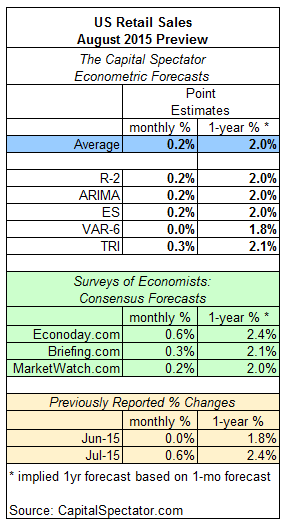U.S. retail sales are expected to increase 0.2% in tomorrow’s August report vs. the previous month, according to The Capital Spectator’s average point forecast for several econometric estimates. The average prediction reflects a deceleration in growth after the previous month’s 0.6% rise.
There’s a relatively wide spectrum of retail sales estimates from recent surveys of economists, with The CapitalSpectator.com’s average forecast at the low end of the projections.
Here’s a closer look at the numbers, followed by brief summaries of the methodologies behind the forecasts that are used to calculate The Capital Spectator’s average prediction:

R-2: A linear regression model that analyzes two data series in context with retail sales: an index of weekly hours worked for production/non-supervisory employees in private industries and the stock market (Wilshire 5000). The historical relationship between the variables is applied to the more recently updated data to project retail sales. The computations are run in R.
ARIMA: An autoregressive integrated moving average model that analyzes the historical record of retail sales in R via the “forecast” package.
ES: An exponential smoothing model that analyzes the historical record of retail sales in R via the “forecast” package.
VAR-6: A vector autoregression model that analyzes six time series in context with retail sales. The six additional series: US private payrolls, industrial production, index of weekly hours worked for production/non-supervisory employees in private industries, the stock market (Wilshire 5000), disposable personal income, and personal consumption expenditures. The forecasts are calculated in R with the “vars” package.
TRI: A model that’s based on combining point forecasts, along with the upper and lower prediction intervals (at the 95% confidence level), via a technique known as triangular distributions. The basic procedure: 1) run a Monte Carlo simulation on the combined forecasts and generate 1 million data points on each forecast series to estimate a triangular distribution; 2) take random samples from each of the simulated data sets and use the expected value with the highest frequency as the prediction. The forecast combinations are drawn from the following projections: Econoday.com’s consensus forecast data and the predictions generated by the models above. The forecasts are run in R with the “triangle” package.












Leave A Comment